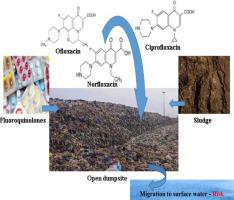Environmental Toxicology and Pharmacology ( IF 4.3 ) Pub Date : 2020-05-15 , DOI: 10.1016/j.etap.2020.103410 Sija Arun 1 , R Mohan Kumar 2 , Jairaj Ruppa 1 , Moitraiyee Mukhopadhyay 1 , K Ilango 3 , Paromita Chakraborty 4

|
Soil and sludge are major reservoirs of organic compounds such as fluoroquinolones (FQs) which are broad-spectrum antibacterial agents. Hence, we monitored three major FQs, namely, ciprofloxacin (CIP), norfloxacin (NOR), and ofloxacin (OFL), in surface soil from two major dumpsites and dry and wet sludge from sewage treatment plants in Chennai city. The mean concentration of FQs in soil and sludge samples were 20 μg/g and 26 μg/g, respectively. Nearly 50% of the total FQs in dumpsite soil was contributed by CIP followed by NOR (32%) and OFL (13%). Similarly, CIP was the major contributor in sludge samples followed by NOR and OFL. The concentration of FQs was two folds higher in wet sludge than dry sludge most likely indicating that water solubility of these compounds might play an important role for elevated level of FQs in wet sludge. Solid waste from pharmaceutical industries, households, and sludge from wastewater treatment plants were expected to be the major source of FQs in dumpsite soil. Predicted risk assessment using soil to water migration concentrations via surface run off indicated high risk to aquatic organisms. However, risk quotient (RQ) was found less to earthworm in most of the soil samples. The findings from this study might help in future policies on disposal of household antibiotics in the solid waste stream.
中文翻译:

来自印度钦奈的垃圾场土壤和污水污泥中氟喹诺酮类化合物的发生,来源和风险评估。
土壤和污泥是有机化合物(例如,氟喹诺酮类)的主要储库,它们是广谱抗菌剂。因此,我们在两个主要垃圾场的地表土壤以及钦奈市污水处理厂的干,湿污泥中监测了三个主要FQ,即环丙沙星(CIP),诺氟沙星(NOR)和氧氟沙星(OFL)。土壤和污泥样品中FQ的平均浓度分别为20μg/ g和26μg/ g。CIP贡献了垃圾场土壤中总FQ的近50%,其次是NOR(32%)和OFL(13%)。同样,CIP是污泥样品的主要贡献者,其次是NOR和OFL。FQs在湿污泥中的浓度比干污泥高两倍,这很可能表明这些化合物的水溶性可能对湿污泥中FQs的升高起重要作用。预计制药行业,家庭的固体废物和废水处理厂的污泥将成为垃圾场土壤中FQ的主要来源。使用通过地表径流从土壤到水的迁移浓度进行的预测风险评估表明,水生生物面临高风险。然而,在大多数土壤样品中发现worm的风险商(RQ)较少。这项研究的结果可能有助于制定未来处理固体废物流中家用抗生素的政策。在大多数土壤样品中,earth的风险商(RQ)较少。这项研究的结果可能有助于制定未来处理固体废物流中家用抗生素的政策。在大多数土壤样品中,worm的风险商(RQ)较少。这项研究的结果可能有助于制定未来处理固体废物流中家用抗生素的政策。


























 京公网安备 11010802027423号
京公网安备 11010802027423号